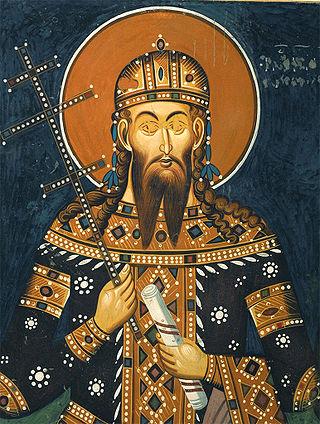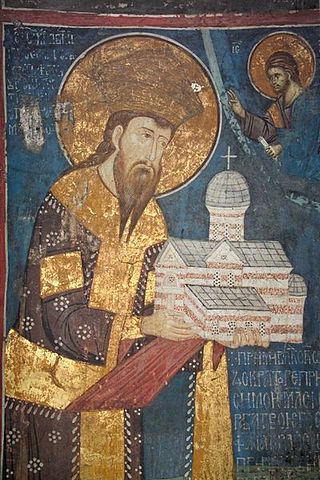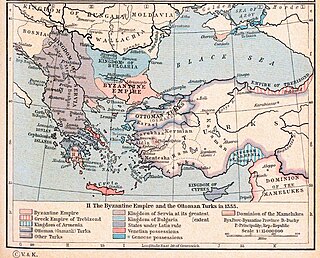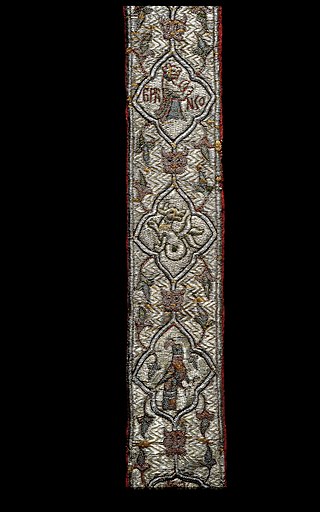See also
- Stefan (surname), a surname
- Stefa, a female given name
- Stefaan, a masculine given name
- Stefen, a masculine given name
- Stephan (given name), a masculine given name
Stefan or Stephan is a masculine given name, a form of the English name Stephen.

Saint Stefan Uroš V, known in historiography and folk tradition as Uroš the Weak, was the second Emperor (Tsar) of the Serbian Empire (1355–1371), and before that he was Serbian King and co-ruler with his father, Emperor Stefan Dušan.

The House of Nemanjić was the most prominent dynasty of Serbia in the Middle Ages. This princely, royal and imperial house produced twelve Serbian monarchs, who ruled between 1166 and 1371.

Danilo II was the Archbishop of Serbs 1324 to 1337, under the rule of Kings Stephen Uroš III (1321–1331) and Dušan the Mighty. As a Serbian monk, he was also a chronicler, active in court and Church politics, holding the office during the zenith of the Nemanjić dynasty-era; he wrote many biographies which are considered part of the most notable medieval Serbian literature. He was proclaimed Saint Danilo II of the Serbian Orthodox Church, and is celebrated on the same day as Saint Ignatius of Antioch on 2 January [O.S. 20 December].
Stephen Uroš is a Serbian royal name, referring to the following members of the Nemanjić dynasty :
Bogdan or Bohdan is a Slavic masculine name that appears in all Slavic countries as well as Romania and Moldova. It is derived from the Slavic words Bog/Boh, meaning "god", and dan, meaning "given". The name appears to be an early calque from Greek Theodore or Hebrew Matthew with the same meaning. The name is also used as a surname in Hungary. Bogdana is the feminine version of the name.

Stefan Uroš III, known as Stefan of Dečani, was King of Serbia from 6 January 1322 to 8 September 1331. Dečanski was the son of King Stefan Milutin. He defeated two other contenders to the Serbian throne. Stefan is known as Dečanski after the great monastery of Visoki Dečani he built.

The Royal Crown of Serbia is a royal regalia that existed during the Serbian monarchy.

Nemanjić family tree
After the weakening of the Byzantine Empire and the Bulgarian Empire in the middle and late 13th century, the northern territory of modern-day Albania became part of Serbia. Firstly, as part of Serbian Grand Principality and later as part of Serbian Empire. Serb control in southern Albania is unclear. Some suggest they acquired towns, but others believe they only obtained submission, possibly nominal, from Albanian tribes. Central and southern Albanian towns were not conquered until 1343–45. Between 1272 and 1368, some areas of the modern-day state were also ruled by the Angevins as the Kingdom of Albania. In the late 14th century, Albanian Principalities were created throughout Albania.

The Kingdom of Serbia, or the Serbian Kingdom, was a medieval Serbian state that existed from 1217 to 1346 and was ruled by the Nemanjić dynasty. The Grand Principality of Serbia was elevated with the regal coronation of Stefan Nemanjić as king, after the reunification of Serbian lands. In 1219, Serbian Orthodox Church was reorganized as an autocephalous archbishopric, headed by Saint Sava. The kingdom was proclaimed an empire in 1346, but kingship was not abolished as an institution, since the title of a king was used as an official designation for a co-ruler of the emperor.

Zeta was one of the medieval polities that existed between 1356 and 1421, whose territory encompassed parts of present-day Montenegro and northern Albania, ruled by the Balšić family from 1356.
Uroš Nemanjić may refer to:
Maria Palaiologina was the Queen consort of Stefan Dečanski (1324–1331). Maria was the daughter of panhypersebastos John Palaiologos, and great-niece of Emperor Andronikos II Palaiologos.
Anna of Serbia may refer to:

Zeta as a crown land was a medieval region and province of the Serbian state of the Nemanjić dynasty, from the end of the 12th century, up to the middle of the 14th century. During that period, regional administration in Zeta was often bestowed to various members of the ruling dynasty, who administered the region as a crown land.

The first mention of a "Serbian dinar" dates back to the reign of Stefan Nemanjić in 1214. Until the fall of the Serbian Despotate in 1459, most of the Serbian rulers minted silver dinar coins.

Branko was a Serbian magnate who served to king and emperor Stefan Dušan, and emperor Stefan Uroš V, with the titles of sluga and later sevastokrator. A member of an old and respectable family, possibly descending from the Serbian dynasty itself, Branko began his royal service in the nearest circle of the ruler. After the elevation of the Serbian state to the Empire (1346), Branko received the second-highest court title, sevastokrator, usually given to relatives. He governed the Ohrid region. Branko had three sons and a daughter, of whom Vuk Branković would become an important person in the period of the Fall of the Serbian Empire.